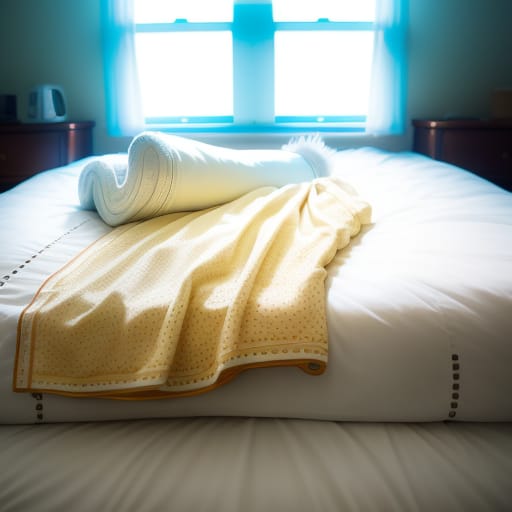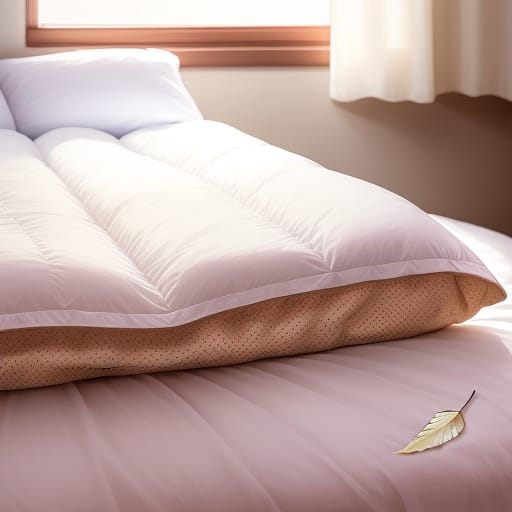Do you love snuggling up under a warm, fluffy down comforter, only to find little feathers and down bits all over your bed in the morning? Shedding is a common issue with down comforters, but with some maintenance and care, you can prevent the shedding and keep your comforter fluffy and fabulous.
This beginner’s guide will walk you through everything you need to know about down comforter shedding – from understanding the causes to learning repair, cleaning, and storage techniques. With the right preventive measures and regular care, you can stop the shedding and extend the life of your comforter.
Why Do Down Comforters Shed?
Before learning how to stop shedding, it helps to understand what causes it in the first place.
Down comforters are filled with the ultra-soft and insulating under-plumage from ducks or geese. This filling is held in place by the comforter’s outer fabric shell and stitching. Shedding occurs when down fibers or small feathers poke through weak spots in the fabric or seams.
Here are the main factors that can cause shedding:
- Poor quality materials – Low thread count fabric and weak stitching lead to the fill escaping more easily. Higher quality materials are more durable.
- Improper construction – Insufficient stitching or thin baffle boxes allow the filling to shift and escape. Proper construction reinforces the comforter.
- Overuse and wear – Filling can poke through worn spots in the fabric over time with regular use.
- Insufficient cleaning – Soil, oils, and dirt can degrade the shell fabric and seams.
With the right care and maintenance, you can tackle these causes of shedding and keep your down comforter in top condition.
Choosing a Shed-Resistant Down Comforter
When shopping for a new down comforter, opt for one designed to resist shedding:
- Higher thread count – Look for a thread count of 300 or higher. The tighter weave helps contain the down.
- Strong baffle box construction – This refers to the stitching that forms small compartments to hold the down in place. Sturdy 1-inch or smaller boxes prevent shifting.
- Higher fill power – This measures the loft and quality of the down. Choose fill power of 600 or higher.
Down alternative comforters made from synthetic materials like polyester are less prone to shedding. They can be a good option for allergy sufferers as well.
Use a Duvet Cover
One of the easiest ways to contain shedding is to use a duvet cover. This is a removable outer shell that protects the comforter itself. It acts as a barrier to catch any escaping feathers or down before they get on your sheets.
- Choose a duvet in a tightly woven fabric – high thread count cotton or microfiber work well.
- Make sure it has corner ties or a closure to secure it around the comforter.
- Wash the duvet cover regularly to remove any shed filling.
- A zippered duvet makes it easy to remove and replace the comforter inside.
Shake It Out and Fluff It Up
Simple routine maintenance can help stop down shifting and shedding:
- Shake out the comforter outside or over a balcony every few weeks. This lets trapped filling redistribute.
- Fluff the down chambers by massaging the comforter. This plumps it back up.
- Use clean tennis balls in the dryer to break up clumps in the filling.
- Avoid compacting or compressing the comforter for long periods.
Handle with Care: Washing and Drying
Proper washing and drying are key to keeping your down comforter fluffy and minimizing shedding long-term:
- Wash in a front-loading machine on a gentle cycle using mild detergent. Never use bleach.
- Air dry if possible or tumble dry low. Add tennis balls to break up clumps.
- Stop the dryer periodically to fluff and rearrange the comforter.
- Once dry, continue fluffing the filling thoroughly.
Tip: Always check the manufacturer’s care label instructions too.
Patch and Repair Small Holes
If you notice small holes where the filling is escaping, you can often patch these up:
- Use iron-on patches or fabric glue to mend tiny holes or weak seams.
- For larger holes, hand-sew a patch of matching fabric over the hole, securing the edges tightly.
- Consult a seamstress or tailor to repair larger seam failures or reconstruct baffle boxes.
- If the comforter is heavily damaged, consider professional reconditioning services.
Reinforce the Shell with Starch
Applying a light starch solution can reinforce the shell fabric:
- Mix 1-2 tablespoons of cornstarch per 1 pint of water. Apply evenly to the outer fabric.
- Let dry fully, then gently brush off any dried starch.
- The starch temporarily stiffens the fabric and helps contain the filling. Reapply every few washes.
- Be cautious with starch sprays as these can clog the fabric if overapplied.

Alternative Filling Options
For severe shedding issues, switching to an alternative down-free filling may be the solution:
- Polyester mimics the soft down-like feel without the shedding and allergens.
- PrimaLoft is a microfiber that provides warmth without shedding.
- Natural wool or cotton fillings are also options but heavier and not as lofty.
- Synthetic filled comforters need less frequent cleaning than down which helps minimize wear.
Store Properly Between Uses
Giving your comforter a break between periods of use can help minimize shedding issues:
- Avoid prolonged compression by folding or tightly packing the comforter. Allow the loft to recover fully when taking out of storage.
- Store in a breathable cotton or mesh bag rather than plastic to prevent moisture buildup.
- For summer storage, use vacuum seal space bags to compress the comforter while protecting the fibers.
- Follow the cleaning schedule recommended by the manufacturer before seasonal storage.
Control Environmental Factors
Down comforters tend to shed more in certain environmental conditions. You can take steps to minimize shedding triggers:
- Low humidity can dry out fibers and cause the shell to degrade faster. Use a humidifier in your bedroom during dry winter months.
- Pets and roughhousing create wear and tear over time. Keep your comforter protected.
- Warm wash and dry cycles can damage fabric and stitching. Stick to cool, delicate settings.
Shedding Doesn’t Mean the End
While shedding can be annoying, it doesn’t necessarily mean you need to replace the comforter if you take action. With proper care and maintenance, a quality down comforter should last many years. Implement preventive measures, repair damage promptly, and clean as directed. Your comforter will thank you!
Key Takeaways:
- Use a duvet cover to protect the comforter shell
- Look for higher thread count, fill power when buying
- Handle gently and fluff regularly
- Clean per manufacturer instructions
- Make repairs as needed with patches or reinforcements
- Consider alternative fills if shedding persists
With some diligence, you can contain shedding and enjoy your warm, fluffy comforter for seasons to come.
Expert Tips to Stop Shedding
We asked bedding experts to share their top tips for keeping down comforters in top condition:
“Focus on quality materials and construction – higher thread count shells and tightly-stitched baffle boxes really do minimize shedding issues.” – Sarah B., Luxury Bedding Manufacturer
“For severe shedding, I recommend professional cleaning 1-2 times per year. The deep cleaning helps remove built up dirt that can damage the shell over time.” – Mark D., Professional Cleaning Service Owner
“Synthetic down alternatives like PrimaLoft have come a long way. The premium qualities feel and insulate like real down with no shedding.” – Emma C., Bedding Retailer
“Be extremely gentle whenever washing and drying a down comforter. Use a duvet cover to avoid cleaning too often.” – Jeff K., Laundry Expert

Real-Life Shedding Solutions
Here are a few real-life shedding situations and how consumers resolved them:
- Sandra’s 2-year old down comforter started shedding excessively. She fixed the problem by using lightweight starch spray on the shell to reinforce it.
- Stephen noticed small holes along the side seams of his comforter. He hand-sewed patches of matching fabric over the weak spots.
- Clara’s comforter looked worn and deflated after 5 years of use. She had it professionally cleaned and restitched by a seamstress to repair damage.
- After trying numerous solutions, Diego opted to replace the original down comforter with a high-end PrimaLoft option. No more shedding!
Frequently Asked Questions
What are the best materials for stopping shedding?
Look for high thread count cotton shells (300+) and high fill power down (600+). Tight baffle box stitching is also important to contain the fill.
How often should I wash my down comforter?
Most experts recommend washing 2-3 times per year. Check the product instructions as well. Use a duvet cover to minimize washing.
When should I consider getting a new comforter?
If the shell fabric is deteriorating and repairs aren’t helping, or the filling is severelycompacted, it may be time for a new down comforter. This usually happens after 5+ years.
Can I fix rips or holes in my down comforter?
Small holes and seams can be patched with iron-on fabric or hand sewing. For large rips, professional reconditioning services can insert new fabric and restitch major damage.
What’s the benefit of tennis balls in the dryer?
The tumbling motion of tennis balls helps break up clumps in the down filling and fluffs the comforter. Just 2-3 balls is sufficient.
In Closing
While down comforter shedding can be an annoyance, there are many preventive steps you can take to contain it and care for your bedding properly. Focus on quality construction, protective outer layers, gentle care, and timely repairs.








